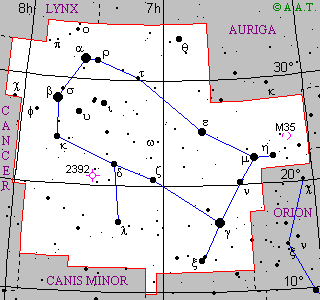 |
 |
| English name | Twins | ||||
|---|---|---|---|---|---|
| Major stars | alpha Geminorum | Castor | magn. 1,6 | RA: 07h 34m 36.02s | Dec: +31° 53' 18.7" |
| beta Geminorum | Pollux | magn. 1,1 | RA: 07h 45m 19.05s | Dec: +28° 01' 34.4" | |
| gamma Geminorum | Alhena | magn. 1,9 | RA: 06h 37m 42.72s | Dec: +16° 23' 57.5" | |
| delta Geminorum | Wasat | magn. 3,5 | RA: 07h 20m 07.37s | Dec: +21° 58' 56.4" | |
| epsilon Geminorum | Mebsuta | magn. 3,2 | RA: 06h 43m 55.92s | Dec: +25° 07' 51.9" | |
| my Geminorum | magn. 3,2 | RA: 06h 22m 57.61s | Dec: +22° 30' 49.0" | ||
| xi Geminorum | magn. 3,4 | RA: 06h 45m 17.38s | Dec: +12° 53' 44.4" | ||
| Description | Constellation of the zodiac, through which the Sun transits from the end of June to the end of July. It is to the northeast of Orion. The constellation is characterized by two near stars of first magnitude: alpha and beta Geminorum. The first one, called Castor, is composed by two white-blue stars and by a red dwarf: and since these three components are all double, Castor is really constituted by a system of well six stars. The second one, Pollux, is a yellow giant brighter than Castor. Castor and Pollux have no bond between them: the distance which separates us from these two stars is, respectively, 45 and 36 light-years. The constellation of Gemini contains a pair of very interesting objects. First of all M35, an open cluster near the border with Taurus: it is constituted by more than a hundred of stars, scattered in a zone as vast as the full Moon; it is 2800 light-years away from us. Secondly, there is NGC 2392, a planetary nebula that appears to the telescope as a bluish disk of eighth magnitude. Seen with a big telescope this nebula has the shape of a face surrounded by a fringe: for this reason it is nicknamed Eskimo Nebula or Clown Nebula. |
||||
| Mythology and history | The constellation represents the twin Castor and Pollux, also known as Dioskouroi, that is "Zeus' sons". Tradition wants, however, that only Pollux was of divine birth, while Castor was mortal, son of Tyndarus king of Sparta: both, however, were children of Leda, Tyndarus' wife and Zeus' lover. The twins were very affectionate each other. Together they joined the Argonauts' expedition (see the mythology of Carina), which they helped on many occasions: Castor, in fact, was a skilled warrior and horse-breaker, while Pollux was an unbeatable boxer. Apollonius Rodius, author of the Argonauts' story, tells that the twins saved the ship Argus during a storm: for this reason they became protectors of the sailors, who believed to see them on the masts during the storms as bright shines (it is the phenomenon today known as St. Elmo's fire). Castor and Pollux clashed with another couple of twins, Ida and Lynceus, because of a dispute about two beautiful girls. Ida struck Castor wounding him to death, while Pollux pierced Lynceus through with his lance: finally Zeus intervened and incinerated Ida with his thunderbolt. Only survivor, Pollux asked and got to divide his immortality with his brother: so, they both spent one day in the hereafter and one day on the Olympus. |
||||
 Back to constellations page.
Back to constellations page.